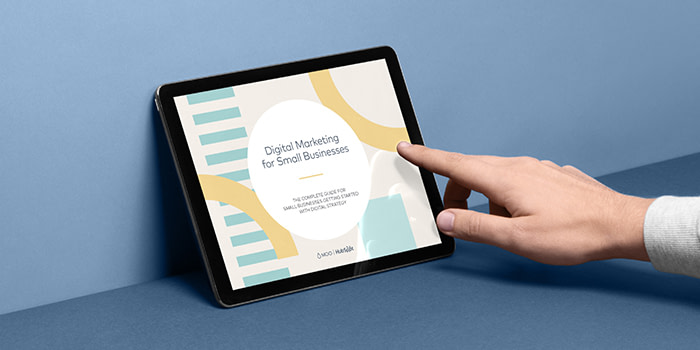Why content marketing is right for your business (no matter what you do)
The smartest B2B organizations entice potential customers with visually immersive, user-friendly content.

When you think about marketing, it may conjure images of mass emails and paid ad placements. But there’s more than one way to generate leads and boost business. With content marketing, you can reinforce your brand identity, increase your online presence and define your business as an expert in your field.
So what exactly is content marketing?
Whether you know it or not, there’s a good chance your business has dabbled in content marketing — or the use of content pieces, such as a corporate blog post, white paper, video content or podcast, to enhance brand recognition, and ultimately sell products or services.
Ever written about the state of your industry or published an interview with your founder? That’s content marketing. Made an informative video in the office and put it on the company’s Facebook or Twitter page? That’s also content marketing.
The many benefits of fresh content
Content has been a big part of marketing plans for years – and with so much of our lives going digital in the past year, the trend is unlikely to let up. In a survey of over 1,500 organizations from SEMrush, 68% of respondents said they expected their content marketing budgets to increase in 2021, a higher number than the previous year. Only 3% of respondents expected a decrease.
Considering all the good that content creation can do for your organization, it’s no wonder so many companies rely on it. Some of the major benefits of successful content marketing:
- Thought leadership: Rather than straightforward promotional copy, content marketing is often more informative (like this blog post, for example). This approach allows you to demonstrate that you’re an expert in your field in a way that feels organic and doesn’t come across as overly sales-y.
- Increased brand awareness: Great products come from great brands. Whether you’re working in a print or digital medium, the more you share your content, the more recognition you can receive. Each new piece of content gives you an opportunity to show potential customers who you are as an organization, and what you value — improving potential brand loyalty.
- Improved search engine optimization: SEO is the set of best practices a content creator uses to rank higher on search engines like Google. While Google’s exact algorithm is kept under wraps, websites with blogs and other forms of content tend to do better. Google wants to present readers with relevant, informative and well-respected pages. Great content is your way of showing you belong at the top of the pile.
- New lead generation: A content marketing campaign is yet another great way to start potential customers in your sales funnel. In the B2B world, customers buy from the company that offers the best product at the best price and backs it up with an established reputation for quality. Content marketing gives you an opportunity to demonstrate all three to your target audience.
Getting your content marketing effort right
With so many companies entering the content marketing fray, a deluge of content for content’s sake simply won’t cut it anymore. The smartest B2B marketers entice a target audience with visually immersive, user-friendly content that speaks to their needs and interests. As you craft a marketing strategy and get creative and focus on the following:
Strike the right tone
While your content marketing efforts may be different from more traditional marketing, it’s still important that you tell the same story across all of your channels. A big part of that is writing content that fits your brand’s overall tone of voice. Your tone of voice is a great way to establish your company’s values without needing to spell them out.
Ultimately, each new piece of content is also an opportunity to establish who you’re writing for. If your blog is too specific, it’ll be hard to appeal to a wider audience. Too basic, however, and you risk reader disinterest.
Much of getting this balance right will come down to how well you understand who your potential customer is. Look at past data to develop a buyer persona — or a fictional representation of a typical buyer. If you’re speaking to multiple types of customers, you can also try segmenting your audience and delivering custom content that suits their specific needs through avenues like an email subscriber list.
Remember the visuals
The most effective marketing materials are a complete package, with the writing enhanced by smart design and striking images. If you aren’t taking your own photographs, free or paid stock images can be an appealing option. Select with caution, though. Drawing from the same sources as everyone else can result in visually bland content — featuring the same stock photo models. Be sure to only pick images that compliment the overall look you’re going for and blend in naturally alongside the other elements of your content.
Your design and images should also keep with your brand’s overall visual identity. Be sure to use the same logos, fonts and color schemes across all your content. A unified look will enhance the professionalism of your website, reinforce brand identity and make your content more memorable. Your digital content should also be optimized to look appealing on multiple devices, not just a laptop.
Diversify your content
While publishing a regular blog post or two can add a new dimension to your website, it’s not the only content type that adds value. Before you begin a publishing push, develop a content strategy that utilizes the channels your target audience is actually consuming. Depending on your sector, that could mean anything from visual content like vlogs to white papers. Wherever your work is being posted, try to maintain consistent style and branding throughout. While a video script and a case study are definitely going to feature different styles of copy, they should still sound like they’re coming from the same organization. Employing a content calendar will also help you keep track of what you’re publishing across a range of channels.
Want to really flex your content marketing muscle? Use print marketing to support your digital content. Try adding QR codes to your business cards or other printed marketing materials that connect customers to your blog, ebooks or social media accounts. This gives buyers something tangible to remember you and also drives web traffic without the use of Google’s algorithm. Print content is especially useful for small businesses looking to differentiate themselves from the competition.
Check for keywords
While developing a content marketing strategy can go a long way toward boosting your website’s SEO, there are additional steps to optimizing blogs and landing pages for search engines. Determining what words and phrases potential customers are searching for when they’re looking for a business like yours — and using them in your content — will make it easier for these customers to find your business. SEO keyword analysis can be performed with multiple online tools, including SEMrush, Moz and Google Adwords’ Keyword Planner.
While using all of the relevant keywords in your text is important, it needs to sound organic. Search engines can spot websites that engage in “keyword stuffing,” and customers will be turned off by the manufactured, impersonal writing. Remember, your content should always be written with customers in mind first and foremost, not an algorithm.
Ready to tell your story with premium printed marketing materials? Check out our business services today.
Fill out the form here and a friendly Account Manager will reach out to you.
Keep in touch
Get design inspiration, business tips and special offers straight to your inbox with our MOOsletter, out every two weeks.








